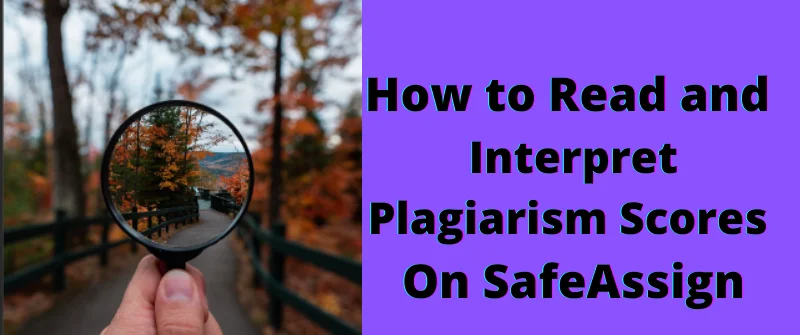Safe assign is a plagiarism detector software that many students use to determine the originality of their work. It works by scanning the submitted work against its several databases like such as campus database, information, or global database.
This software is effective in that it uses a great algorithm to detect matches. It will give a percentage of how your paper matches with other sources.
What is a SafeAssign Score?
A SafeAssign score is a percentage that indicates the similarity of the text in the uploaded file to that of the files on the internet and BlackBoard’s global database. The score acts as an indicator of similarity hence it may not be an indicator of plagiarized work. The professor has to interpret the score to determine if there is plagiarism or not.
This is because the score shows the level of the submitted paper that matches the sources from the existing SafeAssign database.
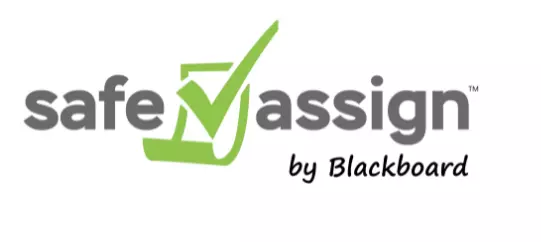
Instructors and students should review their papers to see how they score. By examining the paper, you will take the necessary action concerning plagiarism.
Also, you can employ the SafeAssign alternatives to handle plagiarism before you submit your final draft.
How to Check SafeAssign score
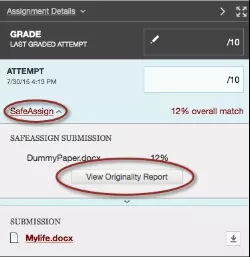
The best way to check the SafeAssign score is to upload the paper as a draft. Suppose they allow for multiple attempts; you will have the chance to see the originality report before submitting it.
nce you upload your document, the SafeAssign will scan your documents and give feedback on the final score.
How to Read and Interpret SafeAssign Scores
Once you upload your document, the SafeAssign will scan it and produce a score for you. The only challenge will emerge if you want to interpret the given score. It will indicate to you the originality report in terms of percentage that matches other works.
Interpreting SafeAssign Scores
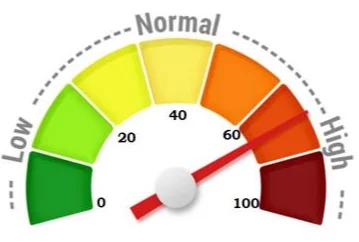
When you see the matching scores, it usually implies that the two phrases may carry similar meanings.
When you read the overall score, you will view the entire percentage of the submitted paper against the existing sources.
Before you interpret the report, it is vital to know the three levels of this plagiarism scanner.
They include as follows:
1. Low SafeAssign Plagiarism Score
It is a type of score that occurs below 15%. If your paper has few common phrases or quotes, it is likely to land in this category. As such, it indicates that your documents have a few matches against other works. Most times, such a paper may not need further analysis.
If the score is below 15%, the paper has some common blocks or quotes that may match other documents. The good news is such papers will not need further analysis since they lack any traces of plagiarism.
2. Medium SafeAssign Plagiarism Level
It is a type of score that comes between 15 to 40 percent. That type of document reflects that that has vast materials that you quoted or paraphrased. It is an excellent indicator that you plagiarized depending on the number of similarities that the software detected.
When the SafeAssign score is between 15% and 40%, then it is an indicator that it has some paraphrased materials or extensive quoting.
More importantly, it may also include plagiarism. As such, the faculty must review such a document to establish if the author attributed the matching content correctly.
However, there are times when Turnitin or SafeAssign scan says you plagiarized but you did not and it is just normal. This is an example of false negatives.
Some institutions accept this level, although the content requires extra interpretation from the professors. Such matches could also indicate that it has some external or copied sources.
Once found in a similar situation, it means it may attract the attention of your instructor. You might have to review it again to determine if the content that has some matching needs proper referencing.
3. High SafeAssign Plagiarism Score
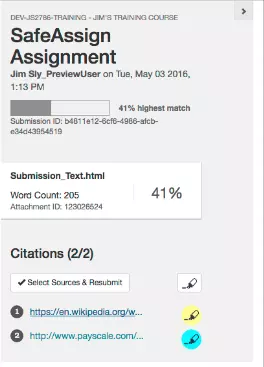
It is a unique score that is above 40%. The situation is an excellent indicator that some sections of your work come from SafeAssign and other online sources.
Any kind of plagiarism that is beyond 40% is highly unacceptable.
Besides, since that paper contains a high percentage of matching text, it may require a plagiarism review.
When the paper scores beyond 40%, it shows that the author copied most of the text from various sources; hence it is plagiarism.
The matching text could include paraphrased or quoted text. Such a paper must undergo review for plagiarism.
The Acceptable SafeAssign Score
Ideally, there lacks an acceptable SafeAssign percentage since every institution has its unique policies on that. The percentage will differ from one university to the next. Remarkably, there lacks a universally accepted level.
However, the commonly acceptable SafeAssign score should be the one that comes below 15 %. This is because low scores show that your submitted work has a few cases of matching text. Most universities regard that as a good similarity score since it lies within safe levels of 0 to 15% similarity.
When your document ranges within this level, it means that your content is above 75% pure work. The remaining percentage is a result of references and quotes to offer evidence to your arguments.
Since SafeAssign recognizes paraphrased and quoted work as matching text, the instructor and the writer must review the paper to handle such cases.
What is a Bad SafeAssign score
A bad SafeAssign score is that one that is 40% and above. Undoubtedly, it is a great indicator that you got most of your content from online sources. It also shows that you have a low original work which references alone cannot explain.
How to Reduce SafeAssign Score
You can guard your paper against any plagiarism, even if it could be accidental. It would be best if you avoided plagiarism as it is an unethical issue that can ruin your academic life. Writing your work while tolerating plagiarism is like theft since you want to benefit from it.
More importantly, you can avoid plagiarism to promote your work integrity. You can use the following method to overcome it and save your career from the associated consequences.
1. Paraphrase
Paraphrasing is a safe method of securing your work to be on the right side by rewriting ideas from your sources.
You can present the information in your text without altering the meaning of the context. In the same vein, you must be careful since paraphrasing can slip into plagiarism when done wrongly.
You have to dance with words to experience successful paraphrasing. The author must reword and format the writing to make it appear original.
You should also endeavor to avoid making use of similar words without diluting the meaning of the phrase. Since you are using someone’s idea, you must cite it correctly.
More importantly, be sure to paraphrase thoroughly to avoid any matches. Remember, SafeAssign checks the Internet, which makes it very accurate to detect any slight copying from the web.
2. Cite Sources
If you are using an idea that originated from someone else’s work, it is vital to add a citation. This could be an in-text citation or using a footnote citation to identify the original author.
Let every citation correspond to the complete reference at the end of your paper. In the process, it allows the readers to locate the sources suppose they want to get additional details.
Several citation styles exist with varying rules. The most common ones are MLA, APA, or Chicago style. Read the instructions well to know which style the instructor recommended.
3. Put Reference Page
It is always reasonable to maintain records of the type of sources you refer to. For instance, you are free to use citation software like Reference Manager to handle all the citations you used in your documents.
You are free to use many references for the background information. For example, instead of referencing a review, you can refer to or cite the individual papers.
4. Use Quotes

One way of avoiding plagiarism is to use simple quotation marks. The text should be within the quotation mark to indicate that the content is not yours.
You can use a direct quote to let the audience know who the owner of those words is.
When you are quoting, it implies that you are copying text by text. You should use the copied text in the original words and enclose it with quotation marks.
After that, you should attribute it to the original author correctly.
Generally, you should quote sparingly. The quotes could only be relevant if you want to use the exact definition as used by the original author.
Also, you can use a quote if you cannot rephrase the text without losing the meaning. Finally, we use quotes to retain the authority and style of the writer’s words.
5. Explain to the Teacher
Lastly, you can access your teacher and explain your case. For instance, it could be accidental plagiarism which may cause your work to lose credibility.
You can review the content with your instructor and perhaps make some necessary changes to make it above the bar.

